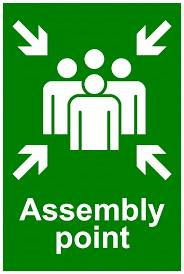
16
Oct
2013

A question we are often asked is: "How often do we need to have a fire drill?" The short answer, according to government guidance, is at least once a year, but it's vital to check out the practicalities of evacuating a building safely first - and to ensure that everyone knows what to do.
In our experience fire drills are essential to test that the processes you have defined really work in practice and that you can get everyone to a safe, accessible place.
Here are some pointers on how best to go about this:
1 Know what's required
UK fire safety law sets down very precise information for owners and occupiers of commercial buildings. This includes the need to provide an emergency plan, giving clear instructions over how people will get out if there's a fire and where they will assemble safely, so that they can be accounted for.
2 Choose your safety spot
The law requires that "emergency exits must lead as directly as possible to a place of safety", defined as "a safe area beyond the premises". It's your responsibility, as owner or occupier of the property, to ensure that the designated area is free from further hazards, for example that it does not block access for emergency vehicles. You also need to check that the assembly point is large enough to accommodate all your staff and any visitors (including those with mobility issues) and that access is not blocked by locked gates or doors which require a key.
You must provide clear signs to show people where to go and how far it is to the nearest exit. See last month's newsletter for further information on this.
3 Tell people what to do
It's your responsibility to share information on fire safety procedures to all members of staff and occasional visitors. Everyone must know what to do if there is a fire and where they need to assemble.
Fire marshalls must be trained to take charge at the assembly point, checking who is present, using an approved list.
4 Fire drills
The best way to check you have complied with all the above is to hold a fire drill. Under the Regulatory Reform (Fire Safety) Order 2005, "the responsible person must establish and, where necessary, give effect to, appropriate procedures, including safety drills, to be followed in the event of serious and imminent danger to relevant persons".
Government guidance on fire safety says evacuation drills should "be carried out at least annually and more frequently if the risk assessment indicates a need for them". This refers to areas considered of high risk, or with a high turnover of staff who might therefore not know what to do.
British Standard BS9999-2008 code of practice for "fire safety in the design, management and use of buildings" suggests holding test evacuations twice in a 12-month period, to ensure everyone is familiar with procedures. It offers the additional good advice that they should also be held after "significant changes to working practices, or the structure of buildings, such as the introduction of tasks that increase the risk of fire, or the addition of new buildings or rooms on the site".
For further information on courses, dates and prices, please contact us.
© Fire Security 2003-2026 - All Rights Reserved
| Company Number: 04677107 Registered In England & Wales
| Privacy Policy
| Cookie Policy
| Terms & Conditions
| Website by 